Tour de France Femmes avec Zwift 2025: A bigger route in both length and severity
The Tour de France Femmes goes up to nine stages in 2025 with three stages in the mountains as the peloton cross the country
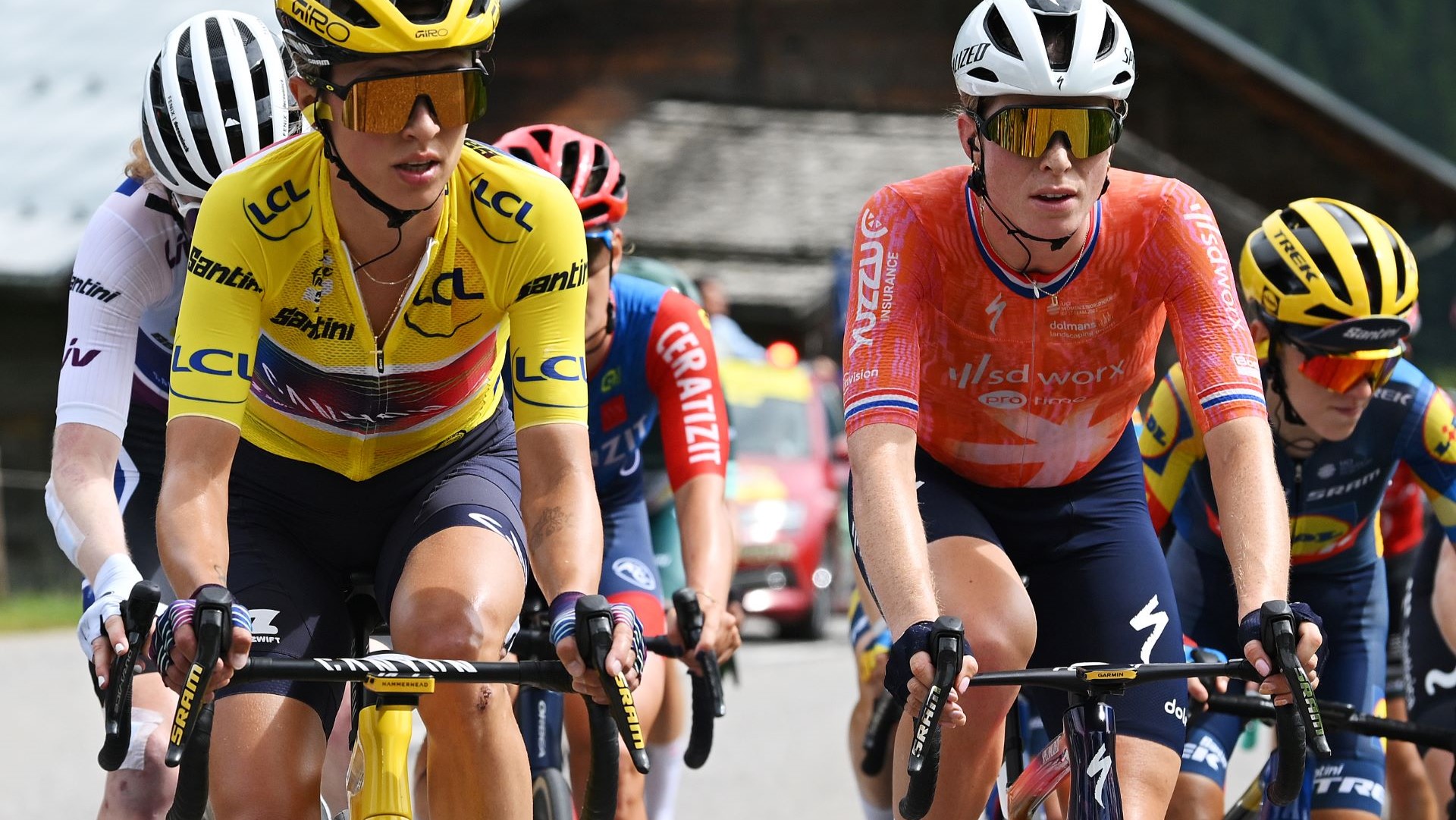

Adam Becket
Every kilometre of this year's Tour de France Femmes avec Zwift takes place on French roads. featuring a ninth stage this year - making it the biggest race on the women's calendar - the route takes the riders from the north west of the country down to the Alps. 1,165 kilometres tracing a diagonal line south east across the country.
154 riders from 22 teams will start in Vannes on the west coast before heading up to Brest, the most westerly point on French soil. From their the route is down towards the Alps via the Massive Central.
Not only are there more stages to tackle, there are more mountains to get over, with the high point of the race being the 2,000m summit of the Col de la Madeleine. The top of this 18.6km climb at the end of stage eight will likely be where the overall winner is crowned.
Tour de France Femmes 2025 route map
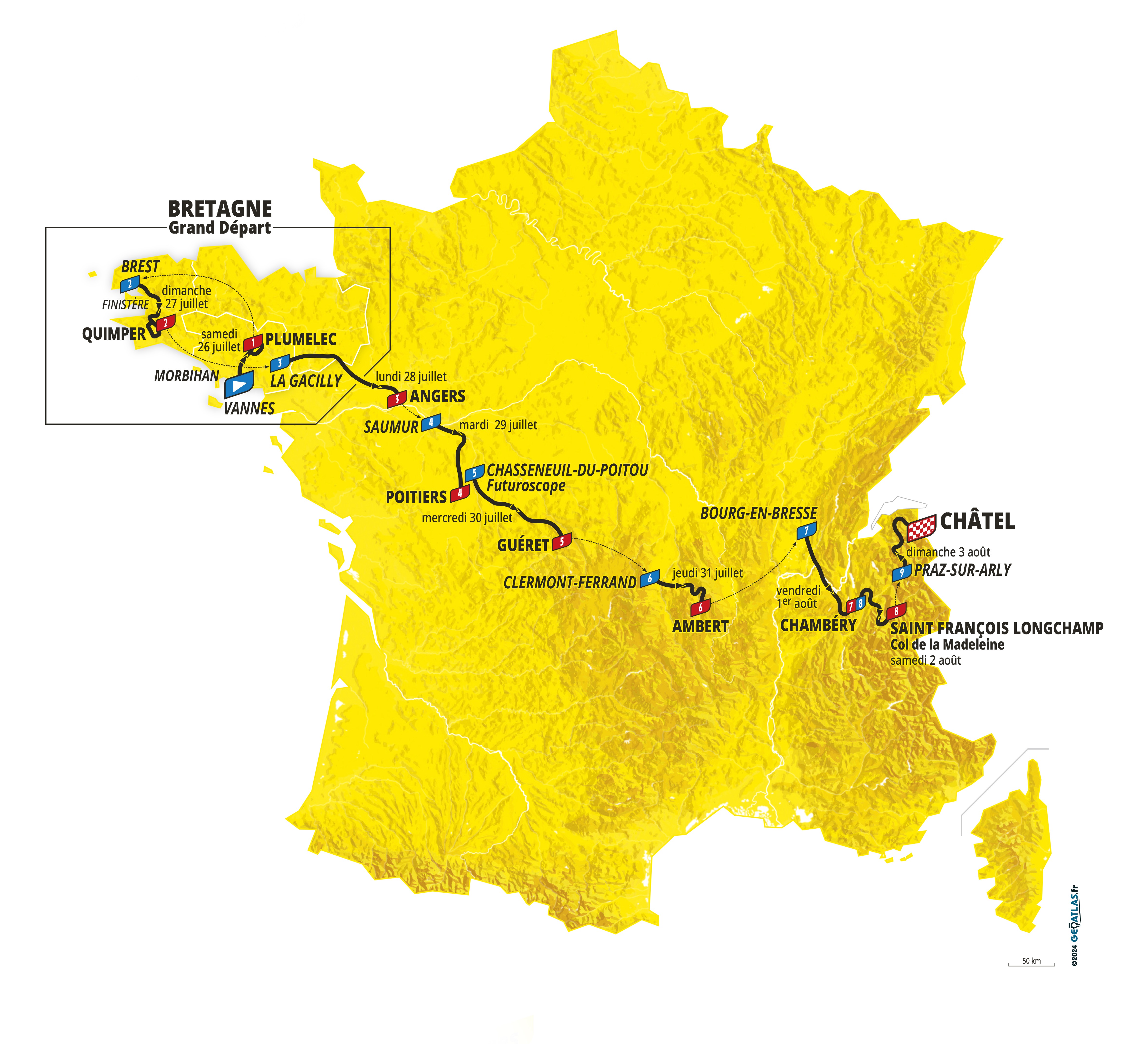
Tour de France Femmes 2025 route map
Tour de France Femmes 2025 stage list
Stage | Date | Start | Finish | Distance | Terrain |
|---|---|---|---|---|---|
One | 26 July | Vannes | Plumelec | 79km | Hilly |
Two | 27 July | Brest | Quimper | 110km | Flat |
Three | 28 July | La Gacilly | Angers | 162km | Flat |
Four | 29 July | Saumur | Poitiers | 128km | Flat |
Five | 30 July | Chasseneuil-du-Poitou | Guéret | 166km | Hilly |
Six | 31 July | Clermont-Ferrand | Ambert | 124km | Mountains |
Seven | 1 August | Bourg-en-Bresse | Chambéry | 160km | Hilly |
Eight | 2 August | Chambéry | Saint François Longchamp | 112km | Mountains |
Nine | 3 August | Praz-Sur-Arly | Châtel les Portes du Soleil | 124km | Mountains |
Stage one: Vannes > Plumelec
Tour de France Femmes 2025 stage one map
The opening stage is a relatively short day, with just under 79km of racing to take place, so expect a fast, furious pace from the off. There are four climbs on the menu, the first the Côte de Botségalo – 0.8km at 5.3% – before three ascents of the Côte de Cadoudal – 1.7km at 6.2% – one of which is the finale.
Only the Botségalo and the second time up the Cadoudal count towards mountains points, however, according the race organisers. What to expect The Tour starts on French soil once again after a brief sojourn to the Netherlands last year, with a punchy stage in Brittany. With a yellow jersey on the line, and a host of contenders ready to take on a relatively open route, expect a lot of action.
The Côte de Botségalo shouldn’t be hard enough to break up the race, but on twisty, narrow Breton lanes, there is every chance for chaos and crashes. As the race enters the finishing circuit, with just over 30km to go, the series of ascents of the Côte de Cadoudal begins. Riders to watch All GC riders will have to be attentive, with time loss a possibility on day one. The finish should be too hard for pure sprinters, but it has Lotte Kopecky (SD Worx-Protime) written all over it, who will be looking to make her mark early in the race. Lianne Lippert (Movistar) is another who could have success in the uphill sprint.
Stage two: Brest > Quimper
Tour de France Femmes 2025 stage two map
The organisers have this down as a flat stage, but the profile suggests otherwise: with four categorised climbs and an uphill finish, it may not be a day for the pure sprinters. Lorena Wiebes (SD Worx-Protime) may be good at getting up hills – as she showed at San Remo Donne this year – but plenty of others with an interest in taking yellow will be pushing the fast women hard in the final.
The latest race content, interviews, features, reviews and expert buying guides, direct to your inbox!
The stage starts in Brest, France’s second most important military port, and finishes in Quimper, which takes its name from the Breton word kemper meaning “confluence”, with the rivers Le Steir and L’Odet coming together in the town. Sprinters will be hoping the race comes back together by the end.
None of the climbs are hard enough to split apart the peloton, but this will be another leg-sapping day in the Breton hills. Anyone dreaming of overall success will have to be switched on. It’s unlikely there will be big time gaps yet, so riders will be hungry for bonus seconds.
If she can stick with the reduced bunch, Wiebes will be a favourite. It might be an opportunity for Marianne Vos (Visma-Lease a Bike), who has taken two stage wins at the Tour before, although not since 2022. For the likes of Demi Vollering (FDJ-Suez) and Kasia Niewiadoma (Canyon-SRAM zondacrypto) chasing GC, the day is unlikely to end in glory, but it could end in disaster if they get caught out on the finishing circuit.
Stage three: La Gacilly > Angers
Tour de France Femmes stage three route map: La Gacilly > Angers
After two hilly days in Brittany, the riders will be relieved to be on their way out of the region to a flat finish in the city of Angers, in France's Pays de la Loire. The only classified climb of the day, the Côte de la Richardière, 1.7km at 4.6%, comes just 34km into the day, and from then on, there are no particularly steep ramps for the riders to worry about. It doesn’t mean they can switch off, though, as in a tightly packed bunch costly mistakes happen all too easily.
The day begins in La Gacilly, which is home of the French cosmetics company Yves Rocher – a botanical garden in the middle of the town is named after the brand. Angers, where the stage finishes, has seen the men’s Tour de France visit on 33 occasions – the last time, Cavendish won the sprint – but never the Femmes. With no significant lumps today, and a bunch finish expected, the yellow jersey is unlikely to change hands. Stage three should be a quiet one for the GC riders. Instead, the spotlight will be on the sprinters, for whom this is a key stage.
Lorena Wiebes (SD Worx-Protime) is undoubtedly the fastest sprinter in the peloton, the Dutchwoman having reached a century of wins earlier this year. However, she failed to achieve a victory at last year’s race, with her compatriot Charlotte Kool (Picnic PostNL) winning twice. Elisa Balsamo (Lidl-Trek) is also very much one to keep in mind, with the former world champion winning five times this year so far.
Stage four: Saumur > Poitiers
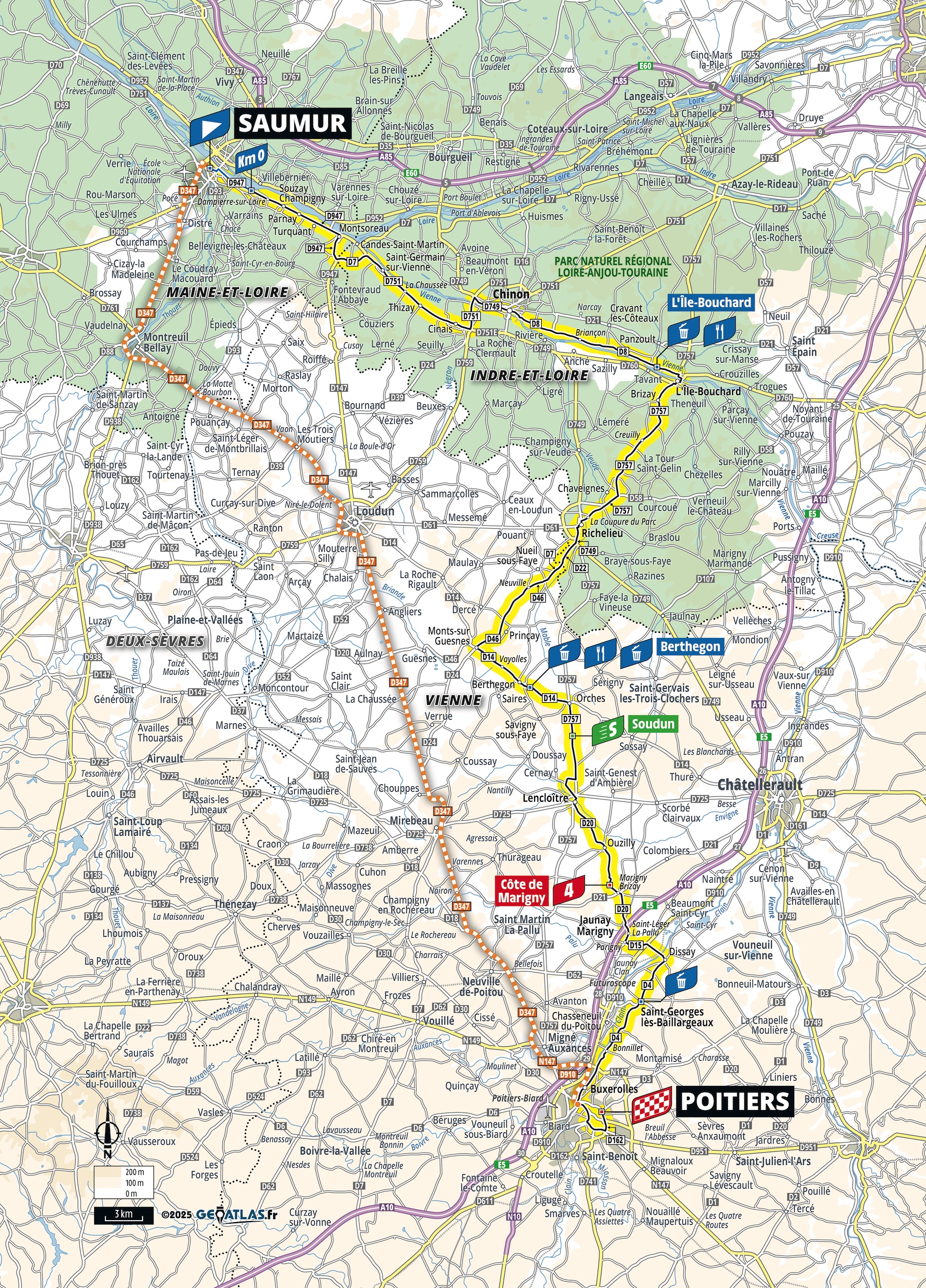
Tour de France Femmes 2025 stage four map: Saumur > Poitiers
It is almost a copy-and-paste of the previous day for the peloton of the Tour de France Femmes: another sprint stage with a largely flat 130km parcours. It begins in Saumur, on the Loire river, upstream from the previous day’s finish in Angers, and heads southeast to Poitiers.
There is just one categorised climb, the Côte de Marigny (0.9km at 5.4%), 29km from the finish, and it’s unlikely to bother the best bike riders in the world. Earlier in the stage, the race passes through Richelieu, a place named after the 17th-century cardinal who built a new town here.
Anything other than a sprint is unlikely, given the flat parcours and the plentiful teams that, at this point in the race, are still interested in a bunch finish. However, with exposed sections along the plains, there is always the chance of wind blowing the race to pieces. If conditions remain calm, it might be a typical transition stage. Indeed, that’s what many of the riders will be hoping for – a relaxed ride across the middle of France, and a chance to recover from the first few days tackled at high intensity.
Lorena Wiebes (SD Worx-Protime), Charlotte Kool (Picnic PostNL), and Elisa Balsamo (Lidl-Trek) remain the fastest sprinters to watch, but others including Chiara Consonni (Canyon-SRAM Zondacrypto), Lily Williams (Human Powered Health), and Marianne Vos (Visma-Lease a Bike) should not be discounted. The women’s peloton has fewer specialist sprinters than the men’s, so expect last-minute attacks and powerful surges from instinctive riders such as Kristen Faulkner (EF Education-Oatly).
Stage five: Chasseneuil-du-Poitou > Guéret

Tour de France Femmes 2025 stage five map: Chasseneuil-du-Poitou > Guéret
The Tour heads south-east again as it continues its march across the middle of the country towards the Alps. After two sprint stages, this is more like the days in Brittany, with punchy climbs in the finale surely splitting the race up.
The route starts reasonably flat, but after about the first 80km of racing, the roads start to head uphill, and with the intermediate sprint at 127km, the action really begins. Two fourth-category climbs follow, the Côte de Chabannes (1.4km at 5.2%) and the Côte du Peyroux (3.3km at 4.3%), and then a bonus sprint on the third-category Le Maupuy (2.8km at 5.4%) before a punchy finish.
The organisers have categorised this as ‘medium mountains’, but this is very much an amuse-bouche for the main course of climbing to come. The three climbs will likely be raced at pace as stage five will be the first real chance since stage two for the yellow jersey to change hands, if nothing chaotic happens. The bonus seconds on offer on Le Maupuy will see the stage light up here, if not before, and it will be a hard task for the sprinters to stay in the peloton. The finish itself is uphill, and it will be a puncheur who wins, almost definitely, if a breakaway can’t stay away.
Demi Vollering (FDJ-SUEZ), the overall favourite for victory, will likely have something to say today, even if she might not have the same punch as Lotte Kopecky (SD Worx-Protime), the world champion. Other riders who might be eyeing a victory in Guéret include Liane Lippert (Movistar), Mischa Bredewold (SD Worx-Protime) and Elisa Balsamo (Lidl-Trek).
Stage six: Clermont-Ferrand > Ambert
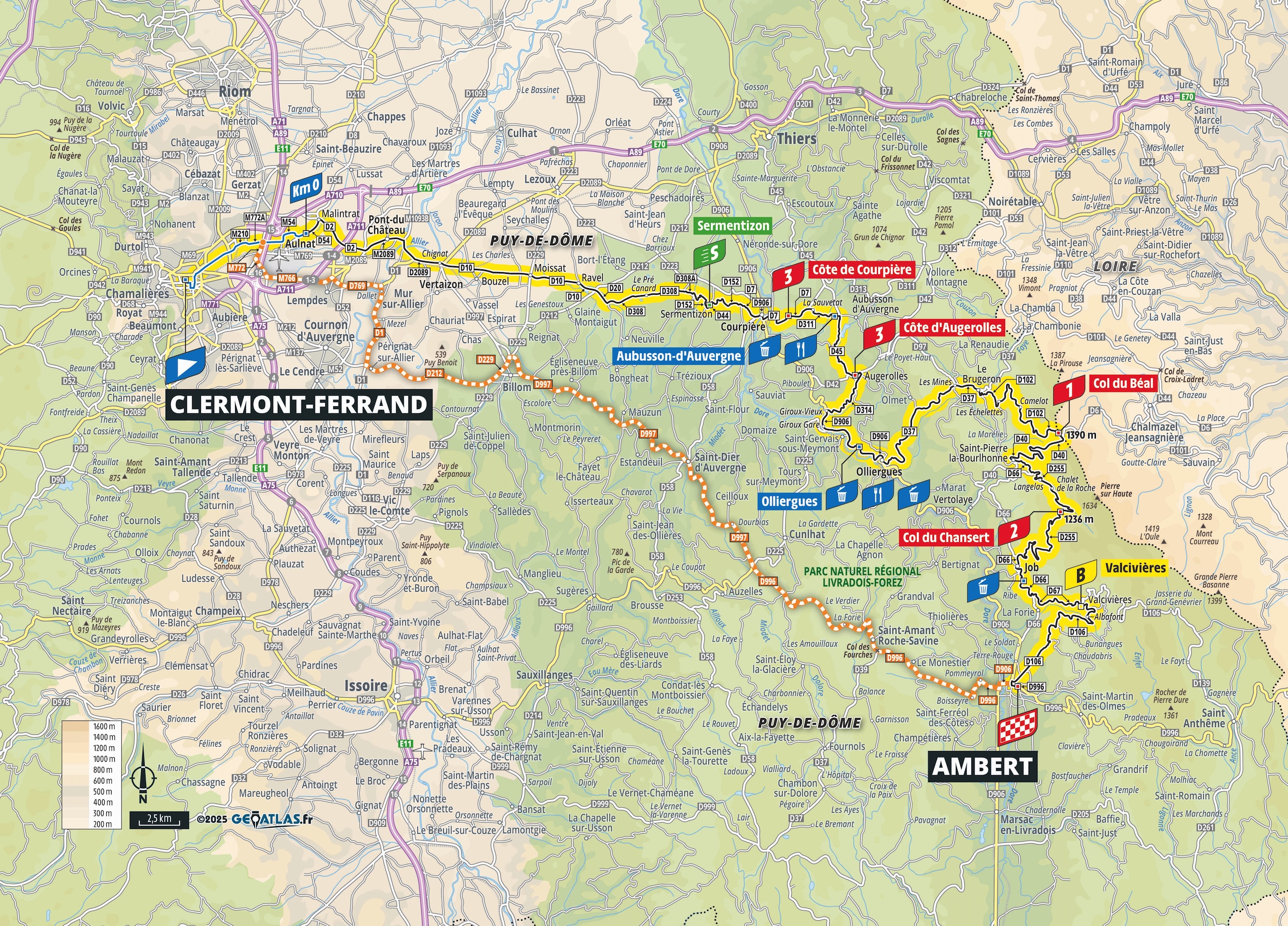
Tour de France Femmes stage six map: Clermont-Ferrand > Ambert
After the prelude, it is time for the mountains to begin on stage six. The race once again heads in a southeasterly direction, with this day taking place within the Puy-de-Dôme department, in the Auvergne. The Tour de France Femmes began in Clermont-Ferrand in 2023, so this is familiar territory.
The day begins simply enough, but the first classified climb comes after 37km, the Côte de Courpière (1.7km at 6.8%), followed by the Côte d’Augerolles.
(2.6km at 5.6%) 10km later. After this, the day’s big test, the Col du Béal (10.2km at 5.6%) is next, with the Col du Chansert (6.3km at 5.5%) the final classified climb of the day. There is a sprint for bonus seconds after a hill with just over 10km to go, before the finish in Ambert.
It looks like the perfect day for a breakaway, with the climbing starting early, and throughout, but without the selective finish that would make it more of a GC occasion. That doesn’t mean those interested in the yellow jersey should take a day off, though, with time gaps a real possibility, and bonus seconds that could be crucial if the favorites are at the front of the race.
This feels reasonably similar to the stage Cédrine Kerbaol (EF Education-Oatly) won last year to Morteau, so mark her out as one to watch. If it’s a breakaway day, the race could be open, with a fierce battle for who gets to be in the selective group. If the wrong person gets up the road, then the chase will be on for those hoping for the overall win.
Stage seven: Bourg-en-Bresse > Chambéry

Tour de France Femmes stage seven map: Bourg-en-Bresse > Chambéry
This transition day is bordering on a full-blown mountain stage. With a 1,100m col placed thoughtfully in the final 20km as the deciding factor, it promises to be a tough day out for all involved and could even see some action on the GC.
The stage heads almost due south from Bourg-en-Bresse to Chambéry on the edge of the Alps, where riders will find two big mountain stages waiting for them over the next couple of days. The profile features three classified climbs, with the cat-two Côte de Saint-Franc coming first at 112km; the cat-four Côte de Berland at 124km; and finally the Col du Granier at 142km, leaving a full 18km of descent to the finish.
With three big climbs concentrated into what is almost the final third of the stage, this section of the parcours will be the decider. An early break is likely to escape during the first flat two-thirds, and will likely be reeled back on the Côte de Saint-Franc. Here we could see a temporary truce or perhaps a more concerted break go clear with serious designs on the stage win. The next two climbs – the Berland and the Granier – more or less merge into one another, forming a major obstacle that will likely see the GC riders attempt to put each other to the sword, and it could well be one of these that wins.
Look out for determined breakaway protagonists who have populated the escape groups all week but have yet to win. Great descenders like Lotte Kopecky (SD Worx-Protime) and Kasia Niewiadoma (Canyon-SRAM zondacrypto) are strong enough to be at the front at the top of the Granier and open a gap on the way down to the finish, too.
Stage eight: Chambéry > Col de la Madeleine
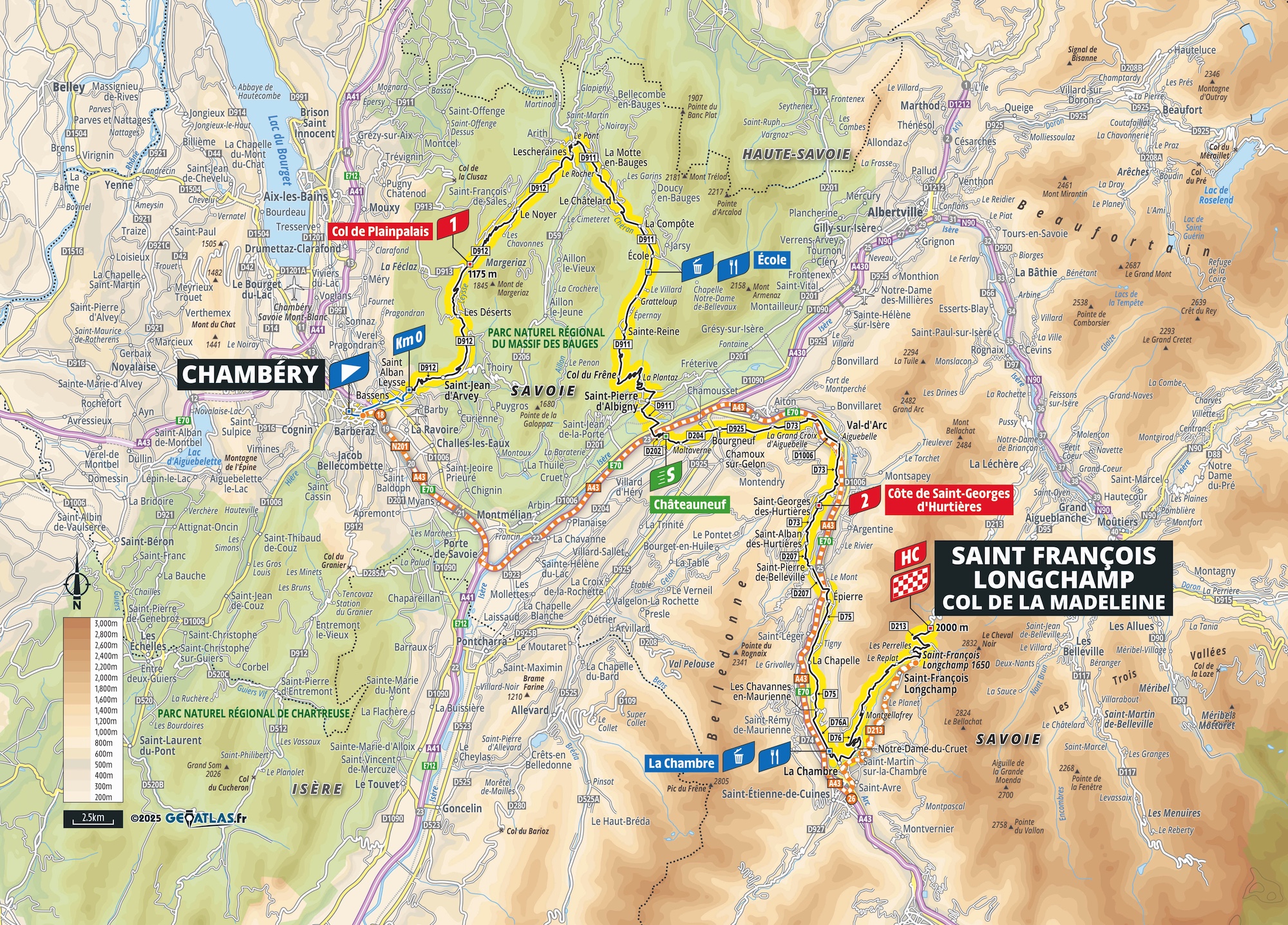
Tour de France Femmes stage eight route map: Chambéry > Col de la Madeleine
This is very much the Queen Stage of this year’s Tour de France Femmes, with a finish atop the Col de la Madeleine in the Alps. The Madeleine is to this year’s Tour what the Tourmalet, Alpe d’Huez, and La Super Planche des Belles Filles have been in previous editions, the key mountain-top finish.
The day begins uphill, with the first-category Col de la Plainpalais straight out of the gate. With 13.2km of climbing and 6.3%, it should drop the sprinters straight away, but the intermediate sprint doesn’t come until 56km in. The Côte de Saint-Georges-d’Hurtières is next, 4.8km at 5.9%, before the Col de la Madeleine looms into view, 18.6km at 8.1%.
The Tour could be all but won on this stage. Expect a lot of action to get into the day’s break early on the Plainpalais, with the race not quiet until the top. Then it will likely be a waiting game until the Madeleine, where a very select group should form, before someone gets away. Last year, Alpe d’Huez saw a lone winner in Demi Vollering (FDJ-SUEZ), but also excellent defensive riding from Kasia Niewiadoma (Canyon-SRAM zondacrypto) as she clung onto yellow. Today's ascent shouldn't be quite that frantic, with one more day to go.
It is hard to look past Demi Vollering, given the Dutchwoman's prowess on longer climbs. Her team-mate Juliette Labous is also an excellent climber, but will likely sacrifice her chances. Also look out for Elisa Longo Borghini (UAE Team ADQ), Niamh Fisher-Black (Lidl-Trek) and Puck Pieterse (Fenix-Deceuninck).
Stage nine: Praz-sur-Arly > Châtel

Tour de France Femmes stage nine map: Praz-sur-Arly > Châtel
The final stage of the Tour, and the third successive day in the Alps, will see the victor of the fourth edition crowned. Unlike the traditional men’s finale, this is no procession. Instead, expect the second-hardest stage of the race. After the Madeleine the day before, there is another hors catégorie climb in the Col de Joux Plane.
The first uphill test of the day, the Côte d’Arâches-la-Frasse, ranks as a first-category climb, 6.2km at 7.1%. The intermediate sprint is next, followed by the Joux Plane, 11.6km at 8.5%. The Col du Corbier comes next, the last opportunity for QOM points at this year’s race, 5.9km at 8.5%, before a punchy finish in Châtel les Portes du Soleil.
The profile has breakaway potential written all over it, but since it is the final stage, it might be ridden very differently. The key climb is clearly the Joux Plane, with its HC status, but given it is so far from the finish, almost 60km, riders are unlikely to want to stay away solo. The Col du Corbier is much more amenable to a solo attacker, with just 30km to go. If there were big gaps on stage eight, expect an element of desperation from teams trying to get something out of this race. The overall winner will be crowned at the summit, so whoever is leading will want to make no mistakes.
Demi Vollering (FDJ-SUEZ) is the best climber in the world, but Anna van der Breggen (SD Worx-Protime) or Kasia Niewiadoma (Canyon-SRAM zondacrypto) could be ascendant or have something to prove at this stage in the race.

Editor of Cycling Weekly magazine, Simon has been working at the title since 2001. He first fell in love with cycling in 1989 when watching the Tour de France on Channel 4, started racing in 1995 and in 2000 he spent one season racing in Belgium. During his time at CW (and Cycle Sport magazine) he has written product reviews, fitness features, pro interviews, race coverage and news. He has covered the Tour de France more times than he can remember along with the 2008 and 2012 Olympic Games and many other international and UK domestic races. He became the 134-year-old magazine's 13th editor in 2015 and can still be seen riding bikes around the lanes of Surrey, Sussex and Kent. Albeit a bit slower than before.
- Adam BecketNews editor
You must confirm your public display name before commenting
Please logout and then login again, you will then be prompted to enter your display name.